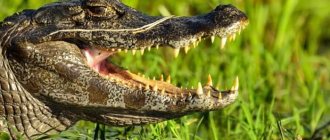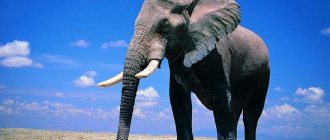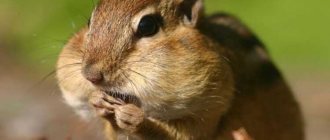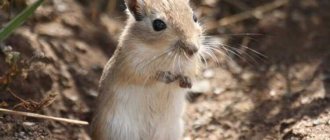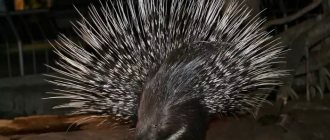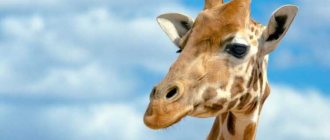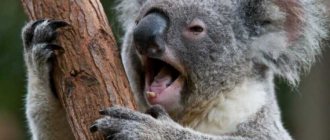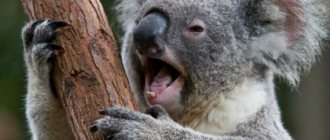Elephants are unique and unusual animals; no other animal can boast the same amazing tusks and trunk. It's easy to make mistakes when drawing elephants because they seem so simple. I'll show you how to draw realistic African and Indian elephants from any angle. Follow me and I will teach you all the elephant wisdom.
Elephant weight
How much can an elephant weigh? It will definitely be difficult to confuse it with other species of animals, since its size is definitely impressive.
Its height can be shown up to 4.5 meters. In terms of mass, it can easily be up to 7 tons. The largest is the African savannah giant.
Our brothers from India will be somewhat lighter and are already 4.5-5 tons.
Among them there are the lightest types and these are forest ones - up to 3 tons. An elephant up to 1 ton can also be found - this is a dwarf variety.
What do they eat?
Elephants are herbivores, typically eating over 100 kg of food per day. In southern India, individuals have been found that feed on 112 types of vegetation, usually grasses related to legumes. Animals also love sedge grasses. Interestingly, these animals can drink 200 liters of liquid per day.
Asaam elephants, living in deciduous forests, include about two dozen herbs and trees in their diet. Among them there is Leersia, but this species is not very popular among elephants in other areas.
The amount of food consumed depends on the season. At the beginning of April, shoots appear, which elephants are very fond of and eat large quantities of them. Then it becomes more difficult to get the plant out of the ground, because the grasses become very tall: more than half a meter. In autumn, animals willingly eat bamboo seedlings, plant stems and shoots.
In winter, Indian elephants actively search for fresh leaves and feed mainly on thorny acacia, that is, the bark of the white type of this plant. They eat tree apples, tamarind and date palm fruits.
In Bardia National Park of Nepal, elephants consume a lot of grass during the winter season, the amount increases during the monsoon period. When the weather is dry, animals eat more bark. It is relevant in cold weather.
Elephant skeleton
In the photo of elephants you can observe the structure of its skeleton. In order for such a tall and heavy animal to move, it has a strong skeleton. Very muscular body.
The head itself in the skeleton will be massive and have protruding frontal tubercles. The ears decorate this large animal, but they also serve for heat regulation. Elephants also communicate with their ears.
Social behavior and reproduction
Female elephants create herds consisting of an experienced female animal, her cubs, and small male and female elephants. In the past, such clans included 20-50 individuals, but now this number has decreased to 5-10. Males prefer to live separately from the herd except during breeding season.
At 15-18 years old, males become sexually mature. Then every year the animals fall into must, that is, into intoxication. The level of testosterone in their blood increases, they behave aggressively and pose a danger to humans. This condition lasts approximately 2 months. Females become ready to breed at 14.
When males are ready to mate, they flare out their ears, which helps the animals spread pheromones. This way they can attract more females. These substances are secreted by a skin gland located in the ear area. Older males, about 50 years old, are more active.
These mammals have the longest pregnancy: 22 months. Females can give birth to only 1 elephant calf in 4-5 years. When born, the baby already weighs about a hundredweight. The height of the newborn is meter.
Almost immediately after birth, an elephant can stand. All females in the herd take care of him. Until the cub is 5 years old, he lives with his mother. After reaching this age, males leave, but females do not. Indian elephants live 50-70 years.
Unusual legs
Knowing how much an elephant weighs, one can assume that it will stomp loudly and generally be clumsy. And this is definitely not about him, he doesn’t stomp, but steps on the surface almost without the slightest noise.
All this happens only because of the existing layer pads on the soles.
But this is not the only thing that hides the uniqueness of the elephant’s legs. He also has two kneecaps on his legs.
Note!
Animals of the Red Book of Russia: complete list of animals, photo, name, description
- A Guide to Fish Oil and Omega-3
Koala: photo, lifestyle, habitat, habits, character, types, interesting facts
Are they really afraid of mice?
The origin of the myth that elephants are afraid of mice is unknown, but many believe that this is the case. There are even theories about what exactly a small mouse can do to scare a four-meter giant: the baby can penetrate the trunk and harm the giant.
Theoretically, this could happen, but it would not be difficult for the elephant to immediately blow it out of there. At the same time, experiments conducted by zoologists prove that in reality the sight of a mouse gives the giant unpleasant sensations. But it turned out that it is not the appearance of the mouse itself that causes hostility, but the rapid movements that it makes. The giant experiences the same negative emotions when he sees a cat or ferret.
Elephant's trunk
And this part of the elephant can be attributed to its individual traits. Its weight can reach 200 kg. From the anatomical structure it is clear that the nose is a fusion of the nose with the upper lip.
One trunk consists of 100 muscles. He will be characterized by strong flexibility and tremendous strength.
Reproductive system
A wild female reaches childbearing age by 10-12 years (in captivity this period may occur earlier). The uterus is bicornuate. The placenta is zonal (girdle) with a falling membrane (decidua). Pregnancy in elephants lasts 640-660 days + 14 days (≈ 18-22 months). Childbirth usually occurs in the spring. The weight of a newborn elephant calf is ≈ 64-97 kg. Typically, a female elephant gives birth to one baby at a time (twins appear in 1-2% of cases); in total, she gives birth to 5-12 babies during her life, but she is often followed by 2 elephant calves of different ages, since she can give birth once every three years. If the mother is disturbed, she carries the cub to a safe place with her trunk, and during the first weeks of life, several members of the herd protect it from predators day and night. Until almost the age of five, the elephant calf sucks milk with its mouth from the mother’s nipples, located between her front legs, and then begins to feed with the help of her trunk. Elephants' testes remain in the abdominal cavity.
Baby Elephant Skills
It is very funny that little elephants control their proboscis very poorly. They are not able to immediately drink water with its help and therefore can simply kneel down and drink directly with their mouths.
The only thing they are able to clearly do with the help of it from the very first days is to hold their mother firmly and well by her tail.
Lifestyle
Indian elephants migrate along strictly defined routes that depend on the monsoon. The leader of the herd remembers the route and is obliged to remind it to the entire clan. Typically, these mammals migrate between the wet and dry seasons. This process is complicated by the fact that the animals may encounter farms on their way, and then the elephants greatly damage the lands.
Animals do not tolerate heat well when they are not afraid of cold. At midday, individuals prefer to spend time in the shade and cool themselves by flapping their ears. Mammals douse themselves with water and wallow in mud lakes, which helps protect themselves from insects and burns. Elephants love to move; the structure of their feet allows the animals to move calmly through the swamps.
If an elephant gets scared, its speed can reach 48 kilometers per hour. When such a situation arises, the animal raises its tail, warning the rest of the herd. Animals are also good swimmers. They sleep about 4 hours a day, and they do this while standing, unless they are sick individuals or children. Animals' sense of smell is excellent, but mammals' vision is poor.
Leather
The elephant animal has a gray and often brown skin. It itself will be dotted with numerous wrinkles and also folds.
The cubs will have some visible stubble on their skin. Which turns out to be practically uncharacteristic for adult individuals.
Enemies in nature
Given their size and power, elephants have no enemies in natural conditions. The only thing that bothers them is various annoying insects, which their thick skin and fanning tail help them get rid of.
However, the main enemy of elephants is, of course, humans, the reason for this is elephant tusks, which are very highly valued, and it is because of this that in the last twentieth century, the population of African elephants simply declined at a catastrophic rate. Part of the efforts to exterminate these giants were “enlightened” white hunters going to Africa on hunting safari. The elephant, which is one of the so-called “African Big Five,” was the desired prey of white hunters. Fortunately, now, instead of hunting safaris, tourists go on photo safaris; elephants are now protected by a number of African states and live in special national parks where hunting wild animals is strictly prohibited.
Jaws
Everyone remembers the famous decoration of an elephant - its tusks. Moreover, the older he gets, the longer they can be.
But this will not always depend only on age. They can also occur differently in different species.
Not all elephants, by the way, can boast of having these tusks. For example, the female Asian elephant is always deprived of such decorations.
What exactly are tusks? In their anatomical structure, it can be seen that they are incisors and fit well into the jaws.
Digestive system
The structure of the digestive system also has features determined by the structure of the teeth and some other organs of the digestive tract. Teeth. The dental formula of elephants is: I 1/1 (incisors - tusks), C 0/0 (canines), P 3-3/3-3 (premolars), M 3-3/3-3 (molars). The molar tooth is formed as if by a stack of transverse vertical plates, each of which is equipped with its own roots with pulp, and all together they are united with cement into a large enamel-dentin block approximately 30 cm long and weighing 3.6-4.1 kg (can reach 5 kg ). Elephants inherited this form of teeth from mastodons. In the most ancient species, the chewing surface of the teeth was covered with transverse rows of cusps covered with a thick layer of enamel. In modern animals the number of transverse rows of tubercles is greater; The tubercles themselves, merging with each other, turn into transverse folds, their enamel layer has become thinner, and a cementing substance has been deposited in the recesses between them. In the modern African elephant, the dentin folds are higher, remaining relatively few and wide. The Asian elephant has the maximum number of dentin folds. They are narrow, tall and close to each other. An elephant has a total of 24 molars, but only one of them is functioning at any given moment on each side of the upper and lower jaws. Having worn out, it falls out, and another, larger one slides out from behind in its place. In this case, the ridges of the previous tooth dissolve. The first pair of teeth in an African elephant falls out at approximately 1-2 years, the second pair - at 3-4 years, the third pair - at 9-10 years, the fourth pair - at 19-25 years, the fifth pair - at 45, the sixth pair - lasts until the end of life. Worn teeth fall out and are replaced by newly grown ones. Elephant calves are born with 2-3 teeth in each dental arch. There are several methods for determining the age of an animal based on the characteristics of the teeth (by the number and type of tooth plates). The tusks are extensions of the upper incisors and do not have roots. They grow in place of small milky tusks called “tusks” (5 cm in African elephants). At 6-12 months, the “fangs” are replaced by tusks. African elephants of both sexes have tusks, while Indian elephants have only males (females can have “tusks”). Tusks grow ≈ 17 cm per year, continuing to grow throughout the life of the elephant (in males they can grow 6 times faster than in females). Ivory (tusks) consists of particularly dense dentin. In living animals, the enamel layer is present only at the very edge of the tusk, but in some extinct animals it continues from there along the tusk in the form of strips of small width. The elephant uses its tusks for digging, stripping bark from trees, tearing off branches, and moving heavy objects. Males can also use them as weapons. The tusks, like the trunk, are used with great care by the elephant; they serve primarily as weapons in defense and attack. In other cases, the animal spares its tusks if possible, since they break relatively easily. Working elephants never use their tusks as leverage when uprooting trees. When lifting weights, the elephant usually takes the end of the rope in its mouth and sometimes places it on one of its tusks at the same time. The condition of the teeth affects the lifespan of an elephant. So, after an elephant wears out its last pair of teeth, it becomes unable to eat properly, which can lead to starvation. The elephant's oral cavity is small relative to the size of the animal. A mobile tongue cannot protrude from the mouth due to the attachment of the tongue to the oral cavity. The elephant's throat is a funnel-shaped tube. In its back part there is a kind of bag located between the base of the tongue and the front part of the epiglottis - the pharyngeal diverticulum. An elephant can hold several liters of water in it for several hours without disturbing the processes of feeding and breathing. The volume of a simple stomach of an adult female Indian elephant can reach 76.6 liters, with a weight of 17-35 kg; in an African elephant, the average stomach volume is ≈ 60+ 5 liters, with a weight of 36-45 kg. An elephant's liver usually consists of 3 lobes. If it consists of 2 lobes, then the right lobe is larger than the left. In females it weighs ≈ 36-45 kg, in males ≈ 59-68 kg. Elephants do not have a gallbladder, but there are channels connecting to the main pancreatic duct and exiting into the lumen of the duodenum. The pancreas weighs ≈ 2 kg. There is virtually no information about diabetes or other diseases associated with pancreatic dysfunction in elephants. The small intestine consists of the duodenum, jejunum and ileum. Its length is 11 – 21 m, volume ≈ 133 liters. The large intestine consists of the cecum, colon and rectum. Its length is 6 – 12 m, volume ≈ 483 m. The total length of the gastrointestinal tract (in African elephants) is ≈ 27 m. The principle of elephant nutrition is to pass the maximum amount of rough, calorie-poor food through the gastrointestinal tract in a relatively short period of time. On average, these animals spend 16–20 hours a day eating. On average, the Indian elephant eats 1.03% (≈ 42 kg) of its body weight, while the African elephant eats 1.6% (≈ 64 kg). Digestion in African elephants occurs faster than in Indian elephants (22.8 - 26.6 hours when digesting hay). Defecation in elephants occurs 15-20 times a day with an interval of 1.09 - 3.33 hours: 5-8 boluses of ≈ 2.5 kg. The average weight of a bowel movement is 10 kg. An African elephant requires ≈ 150-200 liters of water per day, an Indian elephant ≈ 200-255 liters, 3-4 times a day, 50-60 liters each. This is a relatively small amount of liquid. So, for comparison, a horse requires 50-100 ml of water per kg of body weight per day; with this calculation, an elephant would require 200-400 liters of water per day.
Types of elephants
You don't see many species of elephants these days. There are only two: Indian and African elephant. Further, the next division will be in its form. For Africans, these are forest animals and those that live along the equator shrouds.
A very interesting fact is that interspecific crossing is simply impossible. You cannot cross African and Indian, no offspring are obtained, and this is only evidence of a large difference at the genetic level.
Musculoskeletal system
The skeleton of an elephant consists of more than 200 bones. There is a slight difference between the structure of the African and Indian elephant. The Indian elephant has 19 pairs of ribs, 33 caudal vertebrae, 5 nails on the front legs, 4 on the hind legs. The African elephant has: 21 pairs of ribs, 26 caudal vertebrae, 4 nails on the front legs, 3 on the hind legs. On the front legs, the peripheral phalanges of the 2nd, 3rd and 4th toes are not connected to the middle phalanx. Elephants do not have collarbones. The femur and humerus differ in their length relative to the rest of the limbs. When the animal is in a calm position, they have a vertical direction. The ulna is more massive than the radius and intersects with it. The hand and foot are short. The 3rd toe is the most developed. Epiphyseal cartilage is retained throughout the elephant's life. The skull of an adult elephant, although relatively short in length, is distinguished by its considerable height. Compared to the size of the skull, the cranial cavity is very small. The cranial bones are very thick and contain large air cavities between the outer and inner plates of dense bone substance, which in some places exceed the height of the cranial cavity. Such air spaces are present, in addition to the skull bones, in the nasal bones, in the maxillary and premaxillary bones, in all the bones that form the hard palate and the axis of the cranial floor, in the unpaired nasal cavity (mesethmoidae) and in the vomer. The frontal sinuses (sinus frontalis) are especially developed, which continue through the parietal and temporal bones. At a very young age, when the bones are not so thick and the air spaces in them are not developed, the cranial cavity is almost the same size as in an adult animal. It increases very little with age; Only the external dimensions of the skull increase, mainly in height. The sutures between the individual bones are almost healed, and the initially separate air cavities are united. The nasal openings are located very high and face upward and outward. They are extended from right to left and flattened from top to bottom. The premaxillary bones limit them below. The zygomatic bones form the middle part of the zygomatic arches, and their anterior part is formed by the maxillary bones. The lower jaw is distinguished by the length of the ascending bones. The anterior fused ends of both halves are elongated into a pointed protrusion in elephants. The elephant's feet deserve special attention. Circus elephants often suffer from leg disease. To prevent and treat these diseases, it is necessary to take into account their structure and functioning. The foot condition of wild elephants is generally better than that of captive elephants. This is due to the fact that when free, animals constantly move long distances (up to 18 hours a day). They also get minerals and vitamins from natural foods. Most of the time, elephants move, get food, bathe, and dig the ground. By placing its foot on the grass, the elephant pulls blades of grass between its toes, which helps remove growths and cuticles. The anatomy of the feet of Indian and African elephants is approximately the same (slight differences in the shape and number of nails). The feet have 5 fused toes. Basically, only the 2nd, 3rd and 4th fingers have three phalanges, the 1st finger can have only one phalanx, the 5th finger - 2 phalanges. The foot has a covering consisting of skin, nails and a keratinized but flexible sole. The bones of the limbs of the legs are massive, there is no cavity for the bone marrow. This cavity is replaced by a dense network of bones, which make the leg stronger. The carpal bones are shortened and flattened and are an essential part of the leg. The radius and ulna are fixed in an inclined position. The fibula is separate from the tibia. The front legs are longer than the hind legs. The growth of the leg in length occurs due to the lengthening of the middle part. The hind legs are compressed at the sides, giving the foot an ovoid shape (more noticeable in the African elephant). The tarsus consists of 7 bones arranged in 3 rows. The talus and calcaneus make up the middle row, with 2 small articular surfaces between them. The talus is disc-shaped and compressed at the back of the foot. The tubercle of the calcaneus is directed towards the foot. The central tarsal bone is the foot bone of the second row of tarsal bones. The 4 metatarsal bones, which make up the outermost row of tarsal bones, are wedge-shaped. Each tarsal bone is connected to a corresponding metatarsal bone. In the African elephant, the metatarsus contains 4 separate synovial sacs. The metatarsal bones have a widened edge to connect with the phalanx. The 3rd metatarsal is the largest, the 1st metatarsal is the smallest and has a triangular shape. The hind legs have 5 toes that diverge in direction. In the African elephant, the 1st digit is represented by a single sesamoid bone, while in the Indian elephant this digit has one phalanx without a sesamoid bone. The remaining fingers have paired sesamoid bones plantar to the metatarsophalangeal joint. The African elephant's 2nd toe consists of 2 phalanges, while the Indian elephant's has 3 phalanges. The 3rd and 4th fingers are larger than the others. The 5th finger has 2 phalanges (in both types of elephants). The proximal (central) and intermediate phalanges have a 4-sided shape. The 3rd phalanges are slightly elongated, have bilateral transverse processes and one posterior process. The 3rd phalanx is loosely connected by the 2nd phalanx and is hidden in the medial tissue of the corresponding nail. On the front legs, the carpal bones are in the shape of a block, arranged in 2 rows of 4 bones. The proximal (closest to the center) row includes the radius and ulna, the intermediate and accessory carpal bones. The dorsal row refers to the carpal bones (1 – 4). The 1st - 4th carpal bones are connected to the corresponding metacarpal bones, the 4th carpal bone is connected to the 5th metacarpal bone. The peculiar placement and connection of the elephant's carpal bones, different from those of ungulates, allows for slight abduction of the carpus. In the Indian elephant, each of the 3 carpal joints has its own synovial sac. The distal area of the front leg is similar to that of the hind leg. There is a prepollux extending from 1 carpal bone dorsally and 1 metacarpal bone, connecting to the center of the sole. All 5 fingers are supported. In the African elephant, the 1st toe has 1 phalanx and 1 sesamoid bone; in the Indian elephant, the 1st toe has 2 phalanges and 1 sesamoid bone. The remaining fingers have paired sesamoid bones plantar to the metatarsophalangeal joints. The 5th finger has 2 phalanges, the 2nd and 3rd - 3 phalanges. As well as on the hind legs, the 3rd toe is the largest, the proximal and intermediate phalanges have a 4-cornered shape, the 3rd phalanges are slightly elongated, have bilateral processes and one dorsal process. Elephant feet have a unique cartilaginous structure (prehallux). This is a cartilaginous element located at a distance from the 1st metatarsal bone and the tarsal bone. It connects to the digital pad, filled with fibroelastic tissue and located under the tarsus plantar to the fingers (under the fingers). This pad compresses and expands under the elephant's weight, making his leg much more dynamic. The compression and relaxation of the pillow plays an important role in pushing venous blood from the legs into the central venous system. The pad also helps distribute the animal's weight across the entire foot. Located in the center of the elephant’s foot, each time the elephant lowers its foot, it “flattens”, increasing the area of support. This layer serves to stabilize the wrist and fingers on the pad and acts as a shock absorber. This ensures a silent walk, as does the presence of soft pads on the toes. The leg, covered with bag-like skin, swells somewhat when loaded, and when the load is removed, it shrinks in size (when loaded, the circumference of the leg increases by 2.5 - 5 inches, i.e. ≈ 6 - 10 cm). This structural feature allows the elephant to stretch out a leg that has fallen into a swamp without feeling its suction effect, and ensures high maneuverability of heavy elephants on any terrain. The toes are not visible from the outside. Expansion of the toes under the pressure of body weight may be the cause of the semi-plantigrade structure of the hind legs. The pad has few blood vessels and a lot of fatty tissue. In the Asian elephant, plantar (plantar) digital arteries and palmaral digital nerves were found in the pad. The sole of the foot is elastic, 4-12 cm thick, the keratinized layer covers the soles of the feet. On the removed foot, a large number of depressions were discovered, which correspond to outgrowths on the outside, extending into the sensitive dermis. These projections (tubercles) presumably connect the keratinized layer and the underlying sensitive structure. The nail is a plate-shaped keratinization of the outer layers of the epidermis, corresponding to the distal (peripheral) ends of the fingers. The medial part of the nail contains vertical keratinized plates. The sweat glands are located above the fingers. The structure of the leg is adapted to withstand the heavy weight of the animal. Each leg of an African elephant (male) carries a load of ≈ 1500 kg (on average, all elephants weigh 6000 kg). The area of contact with the surface of such an elephant is ≈ 1638.7 cm2, which corresponds to a pressure of 0.92 kg/cm2. During movement, when one leg rises up, the other legs withstand a load of 2000 kg and experience a pressure of ≈ 1.22 kg/cm2. Elephants (wild and captive) move back and forth when at rest, thereby transferring weight from one leg to the other. This is a natural behavior of the elephant, in the process of which blood circulation is stimulated from the peripheral parts to the heart. Peripherally, blood moves easily, but when returning, the blood must overcome stagnation of blood in the long limbs. Moving from one leg to the other facilitates blood circulation in the legs. Being in a limited space, elephants are deprived of the opportunity to move for the required amount of time, which leads to diseases (arthritis, etc.).
